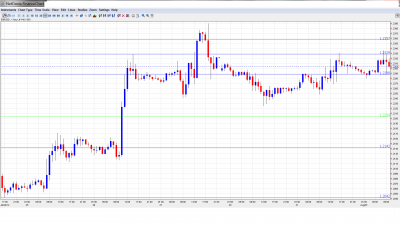EUR/USD inched upwards, as the markets anxiously await announcements by the Federal Reserve and the ECB. The Fed will be releasing a statement on Wednesday, and the ECB will meet on Thursday. The markets will be hoping for some concrete steps from the powerful central banks. The markets will be busy today, with a string of economic releases out of the Euro-zone and the US. Key releases from the US include – ADP Non-Farm Employment Change, US ISM Manufacturing PMI and the Federal Reserve Policy Statement.
Here’s an update about technical lines, fundamental indicators and sentiment regarding EUR/USD.
EUR/USD Technical
- Asian session: Euro/dollar crossed the 1.23 line, reaching a high of 1.2318. The pair then consolidated at 1.2308. The pair is unchanged in the European session.
- Current range: 1.2288 to 1.2330.
Further levels in both directions:
- Below: 1.2288, 1.22, 1.2144, 1.2043, 1.20, 1.1876 and 1.17.
- Above: 1.2330, 1.2360, 1.24, 1.2440, 1.2520 and 1.2623.
- 1.2288 is providing weak support, with stronger support at 1.22.
- 1.2330 is the next line of resistance.
Euro/Dollar pushes above 1.23 line as markets eye Fed, ECB meetings – click on the graph to enlarge.
EUR/USD Fundamentals
- 7:15 Spanish Manufacturing PMI. Actual 42.3 points.
- 7:45 Italian Manufacturing PMI. Exp. 44.2 points. Actual 44.3 points.
-
8:00 Euro-zone Final Manufacturing PMI. Exp. 44.1 points. Actual 44.0 points.
-
12:15 US ADP Non-Farm Employment Change. Exp. 121K.
-
13:00 US Final Manufacturing PMI. Exp. 51.9 points.
-
14:00 US ISM Manufacturing PMI. Exp. 50.3 points.
- 14:00 US Construction Spending. Exp. +0.5%.
- 14:00 US ISM Manufacturing Prices. Exp. 39.3 points.
- 14:30 US Crude Oil Inventories. Exp. -1.5M.
- All Day: Total Vehicles Sales. Exp. 14.0M.
- 18:15 US FOMC Statement.
- 18:15 US Federal Funds Rate. Exp. <0.25%.
EUR/USD Sentiment
- Fed unlikely to introduce QE3: The Federal Reserve will release a policy statement on Wednesday. The US economy has not been looking good lately, with recent housing data and durable goods posting weak numbers. Growth was slow in Q2: 1.5% according to the first release. This is a favorable situation for the dollar: data is weak enough to show that the US is not an engine of global growth, but not weak enough to trigger dollar printing from the Fed. The markets may be disappointed once again as the Fed is likely to “talk a good talk” but remain on the sidelines.
- Markets want action at ECB meeting: The head of the ECB and European leaders have pledged to do everything to save the euro, but can they deliver? The markets remain wary and cautious. High on the agenda is the issue of Spanish and Italian borrowing costs, which have been reaching dangerous levels. The central bank will be under pressure to announce concrete steps to tackle the crippling debt crisis at its Policy Meeting on Thursday. See the ECB preview for all the details.
- Germany opposes bond buying: ECB head Draghi has hinted that the ECB would buy sovereign bonds from Italy and Spain. German finance minister Wolfgang Schäuble has rejected the idea, and also the conservative central bank in Germany continues rejecting it. The head of the Bundesbank Jens Weidmann and Draghi will meet before Thursday’s ECB meeting. There are reports that Germany and the ECB haveoffered to help Spain with lowering bond yields if the nation launches new budget cuts. Traders should be careful, as there is good reason to be cautious, if not skeptical about what steps the ECB is prepared to take in to tackle the crippling debt crisis affecting the Euro-zone.
- Germany not immune from Euro-zone contagion: If the euro still is a new Deutschmark, there are enough reasons to be worried. German Services and Manufacturing PMIs both came in below the market forecast, indicating weakness in those sectors of the economy. This was followed by an awful Business Climate release, as the indicator fell below the market estimate and hit a two-year low in the process. Retail Sales was also well below the market estimate. The markets are clearly getting nervous, as a Germany in decline could spell disaster for the struggling Euro-zone and send the euro tumbling. In addition, Moody’s reduced the outlook on Germany, the Netherlands and Luxembourg from stable to negative.
- Spanish regions want in on the bailout: The euro-zone’s fourth largest economy is trying to focus the crisis on the banks, but also its regions are in deep trouble. No less than 6 regions may ask to tap into the national bailout fund. National sentiment is strongly felt in Catalonia. Spanish yields remain at around 7%, and this is clearly unsustainable. There is growing speculation about a full sovereign bailout, worth 300 billion euros. This is in addition to the 100 billion euros earmarked for the banks.
- Grexit fears rise as Greece to run out of money on August 20th: Fears of a Greek exit from the Euro-zone have again surfaced. Greece is already running into difficulty meeting its bailout obligations, such as debt-to GDP targets, and this could jeopardize the bailout funds. Germany continues to take a tough line with Greece, as German Vice Chancellor Philipp Roesler warned that Greece must adhere to austerity measures in order to receive bailout funds. Meanwhile, the troika, comprised of the European Commission, ECB and the IMF, are holding talks with the Greek government in an attempt to resolve the latest crisis. Greece announced new austerity measures, but will it be enough to convince the troika? The country has to pay over 3 billion euros to the ECB on August 20th, and it doesn’t have the money at the moment.
- High yields and crushing debt weigh on Italy: Doubts about Draghi’s seriousness can be seen in his own country. The area’s third largest economy raised money in the markets with a yield of 5.96%, higher than 5.82% seen last time. The specter of early elections in which the anti-euro sentiment will gain traction also weighs on Italy, that now has a debt-to-GDP ratio of 123%, and a contracting GDP.

